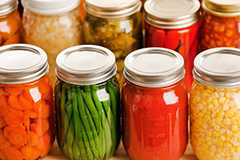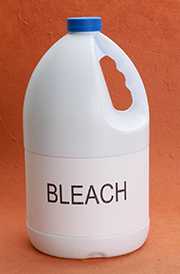Home-Canned Foods

Protect Yourself from Botulism
Foodborne botulism is a rare but serious illness caused by eating foods that are contaminated with the disease‑causing toxin. You cannot see, smell, or taste botulinum toxin – but taking even a small taste of food containing this toxin can be deadly.
Click on the following tips for details on how to protect yourself and the people you feed.
When it doubt, throw it out!
Store home-canned foods for recommended times only. After preparing safely, label and date the jars and store them in a clean, cool, dark place. For best quality, store between 50°F and 70°F. Can no more food than you will use within one year, unless directions for a specific food give other advice.
Before you open a store-bought or home-canned food, inspect it for contamination. Suspect contamination if the container:
- Is leaking, has bulges, or is swollen
- Looks damaged or cracked
If you think the food might be contaminated, do not open the container and throw it out!
Even containers that look fine on the outside might have contaminated food inside. Suspect contamination if:
- The container spurts liquid or foam when you open it
- The food inside is discolored, moldy, or smells bad
If your container or the food inside have any of these signs of contamination, throw it out! Follow the instructions below to throw the food out safely. These actions will help you prevent people and animals from accidentally coming into contact with food that may be contaminated.
Safely throw away food and cans that may be contaminated.

- Put on rubber or latex gloves before handling open containers of food that you think may be contaminated.
- Avoid splashing the contaminated food on your skin.
- Place the food or can in a sealable bag, and seal it shut.
- Wrap another plastic bag around the sealable bag.
- Tape the bags shut tightly.
- Place bags in a trash receptacle for non-recyclable trash outside the home and out of reach of other people and pets.
- Don’t discard the food in a sink, garbage disposal, or toilet.
- Wash your hands with soap and running water for at least 2 minutes after handling food or containers that may be contaminated.
Use a bleach solution to wipe up spills of food that may be contaminated.

- Add ¼ cup bleach for each 2 cups of water.
- Completely cover the spill with the bleach solution.
- Place a layer of paper towels, 5 to 10 towels thick, on top of the bleach.
- Let the towels sit for at least 15 minutes.
- Wipe up any remaining liquid with new paper towels.
- Clean the area with liquid soap and water to remove the bleach.
- Wash your hands with soap and running water for at least 2 minutes.
- Discard sponges, cloths, rags, paper towels, and gloves that may have come into contact with contaminated food or containers with the food. To discard safely, follow instructions for discarding food that may be contaminated.
Home Canning and Botulism
Know the risks of botulism from home-canned foods
Home-canned vegetables are the most common cause of botulism outbreaks in the United States. From 1996 to 2014, there were 210 outbreaks of foodborne botulism reported to CDC. Of the 145 outbreaks that were caused by home-prepared foods, 43 outbreaks, or 30%, were from home-canned vegetables. These outbreaks often occurred because home canners did not follow canning instructions, did not use pressure canners, ignored signs of food spoilage, or didn’t know they could get botulism from improperly preserving vegetables.
Use proper home canning techniques
What's a low-acid food?
Low-acid foods have a pH greater than 4.6. Examples of low-acid foods are:
- Asparagus
- Green beans
- Beets
- Corn
- Potatoes
- Some tomatoes
- Figs
- All meats
- Fish and seafood
- The best way to prevent foodborne botulism is by carefully following instructions for safe home canning in the USDA Complete Guide to Home Canning.
- Use a pressure canner for low-acid foods and follow all specified home-canning processing times for safe home canning of all foods.
- Pay special attention to the processing times for low-acid foods (pH >4.6), which include all vegetables, some tomatoes, figs, all meats, fish, and seafood. Discard all swollen, gassy, or spoiled canned foods safely.
- Before eating home-canned tomatoes, foods containing home-canned tomatoes, or any home-canned foods that are low in acid, boil in a saucepan, even if you detect no signs of spoilage.
- At altitudes below 1,000 feet, boil foods for 10 minutes.
- Add 1 minute for each additional 1,000 feet of elevation.
- If you know foods were underprocessed according to the current standards and recommended methods, do not eat them and throw them out safely.
For more information and guidance on home canning, you can contact your state and county Extension Service Agents.
Top of Page- Page last reviewed: May 8, 2017
- Page last updated: June 16, 2017
- Content source:


 ShareCompartir
ShareCompartir